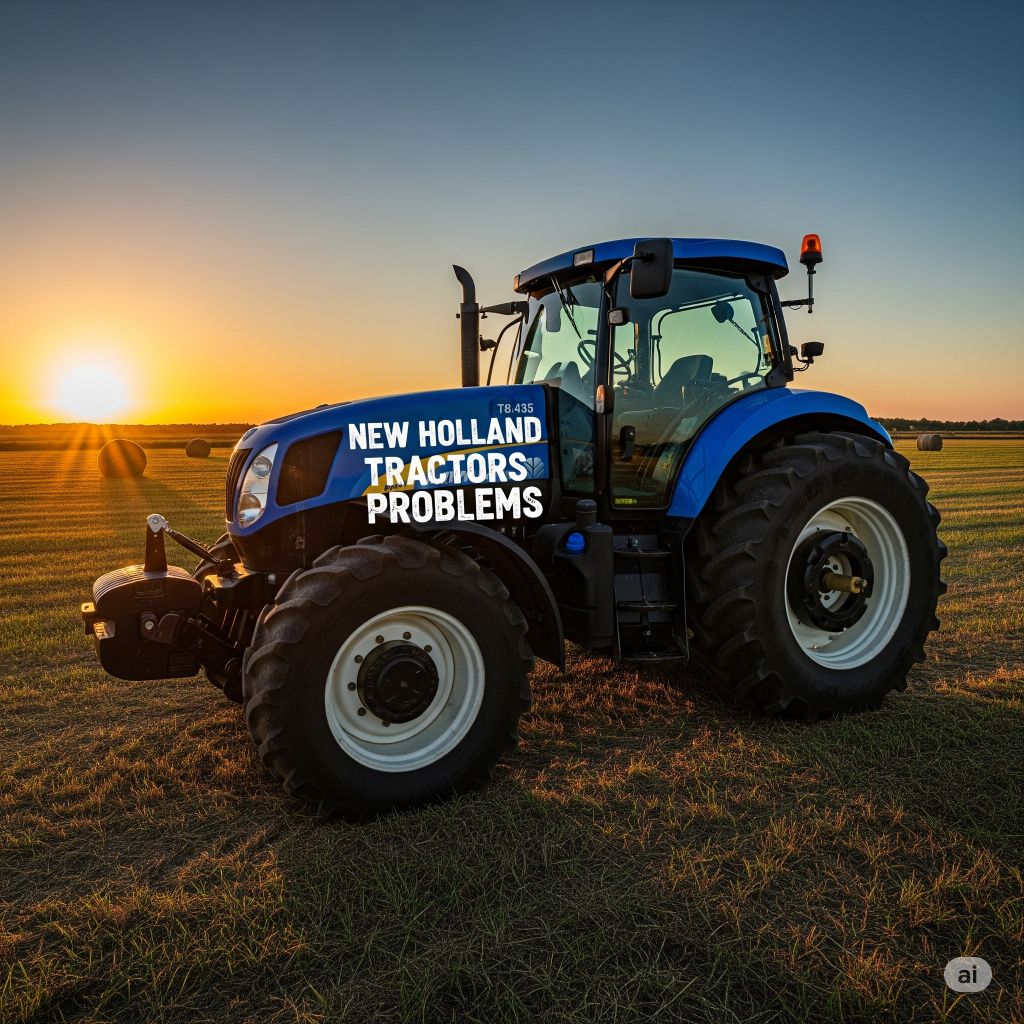
New Holland (part f CNH Industrial) produces a wide range of tractors—from compact sub‑50 HP units up through powerful row‑crop and vineyard machines. While many of their models strike a dependable balance of performance and affordability, others (especially during transition years or early design runs) have been known for persistent issues.
Here is a comprehensive guide on New Holland tractors—covering common problems, practical fixes, series‑wise reliability assessment, and specific models and production runs to avoid when buying or restoring.
1. COMMON PROBLEMS & DIY FIXES
1.1 Emissions-Related DEF/DPF Issues
- Symptom: Engine derates, warning lights, frequent forced regen cycles, reduced power under load.
- Cause: Clogged diesel particulate filter, faulty DEF dosing pump or sensor, regen cycles not completed.
- Fix: Complete a proper regeneration cycle; keep DEF fresh in sealed containers; replace failed sensors or DEF pumps; download any firmware updates from a service dealer.
1.2 Transmission Slips or Hard Shifting
- Symptom: Jerky gear changes, slipping under load, inability to shift smoothly, transmission fault codes.
- Cause: Old or wrong transmission fluid, worn clutch or synchros, misaligned shift linkage or bad shift solenoids (CVT).
- Fix: Change to correct CNH-specified fluid, flush filters; recalibrate shift modules; check and adjust linkages or replace gradual wear parts.
1.3 Hydraulic Delays or Leakage
- Symptom: Slow front‑loader response, hitch dropping under load, erratic implement control.
- Cause: Dirty hydraulic lines, air entrainment, failing relief valves or seals.
- Fix: Flush reservoir and lines; bleed the system fully; install updated valves or seals; replace suction plate/filter if necessary.
1.4 Electrical Faults or Sensor Errors
- Symptom: Dash errors, intermittent displays, GPS or ISOBUS faults, diagnostic alarms.
- Cause: Corroded connectors, water ingress into junction boxes, outdated engine management software, connector pin damage.
- Fix: Inspect and reseal electrical junctions; clean grounds with dielectric grease; update ECU software; replace faulty sensor or control module where needed.
1.5 Overheating and Cooling System Failures
- Symptom: Elevated coolant temperatures, thermostat cycling, engine power loss in summer or heavy work.
- Cause: Clogged radiator fins, failing water pump, old coolant or broken fan clutch.
- Fix: Clean or pressure-wash radiator; install new thermostat or pump; upgrade to premium coolant; consider electric fan upgrade kits where available.
1.6 Diesel Engine Cold-Start Difficulty
- Symptom: Slow cranking, no crank, or white smoke after startup in cold environments.
- Cause: Weak glow plugs (on Tier 3 units), poor wiring connections, battery drain or low voltage.
- Fix: Use Amber-grade diesel or block pre-heaters in winter; replace glow plugs; upgrade battery; ensure proper circulation in starter circuit.
2. SERIES‑WISE RELIABILITY OVERVIEW
🔹 Compact Utility Series (20–50 HP): Boomer, Workmaster, Boomer R/N/Plus
- Strengths: Lightweight, nimble, easy to maintain.
- Weak Spots: Early Boomer N struggles in cold climates, poor loader control response on older hydrostatic transmissions.
- Fixes: Use winter-specific hydraulic fluid; upgrade loader valve if sluggish; check PTO coupling regularly.
🔹 Mid-Utility Series (55–90 HP): TD, T4 Compact, Workmaster 65/75
- Strengths: Good balance of power for loader, mowing and light tillage.
- Weak Spots: Transmission shifting stiffness in early T4 models; brake fade under trailer loads.
- Fixes: Adjust clutch pedal travel, rebuild linkages if needed; install upgraded brake linings; monitor fluid temperature under load.
🔹 Row-Crop/U Utility Series (100–170 HP): T4, T5, T6
- Strengths: Tier 4 Final engines (FIAT Powertrain/NEF), efficient cab platforms, strong hydraulics.
- Weak Spots: Early T6 units (2013–2015) had DPF clogging issues; T5 Auto Command (CVT) transmission hesitation in certain software revisions.
- Fixes: Run tractors at RPMs sufficient for DPF regeneration (2000+ rpm), clean turbo regularly, update CVT firmware, check shift pressure sensors.
🔹 High-Horsepower Tractors (T7, T8, T9, Steiger Series)
- Strengths: High torque, dual-range transmissions, integrated precision farming features.
- Weak Spots: Complex DEF/DPF systems; early T9 had fuel contamination and injector issues; Steiger transmissions sensitive to gear thermal overlap.
- Fixes: Monitor fluid cleanliness and filter change intervals; complete parked regens early; download transmission tuning updates; run DPF clean-out with engine off.
🔹 Specialty Tractors: Row-Crop Instruments like T4F, T6F, Two-wheel row crop, DV/PN Tractors in Vineyard Series
- Strengths: Narrow-track designs for specific applications; advanced steering; ISOBUS compatibility.
- Weak Spots: Early models had hydraulic hose routing cracks from movement; cab dust ingress near controls.
- Fixes: Route hoses with proper clamps, monitor hose abrasion; seal cab penetration points; verify implement wiring integrity.
3. MODELS TO AVOID: SPECIFIC NEW HOLLAND TRACTORS
While many New Holland tractors perform well in real-world conditions, these specific models or production years have recurring faults and are best avoided unless fully service-inspected or dealer-updated:
❌ Boomer 50 (2009–2012)
- Known for hard starting, stuck PTO couplers, and battery drain in 4WD units.
- Avoid unless battery circuit is healthy and PTO function verified.
❌ T4.75 / T4.90N (2014–2016 Tier 4A models)
- Some units had DEF dosing pump failures, intermittent engine derates, and multiple warning lamps.
- Unless dealer-updated to Tier 4B specs, these are likely to cause frustration.
❌ T5.95 Auto Command (2013–2016 early CVT)
- CVT shift module hesitation and rough transition between torque rise and shift.
- Skip unless retrofit software patches have been confirmed.
❌ T6.165 (2013–2015 mid-range)
- EFI sensor glitch, turbo boost sensor failure, and short-term DPF clogging were common.
- Choose post‑2016 models or upgraded engine management versions.
❌ T8.435 (2014–2017 Steiger)
- Transmission hiccups, erratic downshifting under load, DEF pump failures.
- Better options available in late‑series T8 or T9.
❌ T9.565 (2015 Launch Units)
- Fuel injector module problems, fuel rail pressure failures, and injector data mismatch errors led to limp mode events.
- Avoid unless serial number reflects production after firmware recall.
❌ T6F / Narrow Orchard Tractors (first‑gen, 2012–2014)
- Narrow chassis often had hydraulic hose chafing due to tight routing, hoses leading to leaks or pinching cracks.
- Only buy updated or retro‑fitted chassis units.
4. MAINTENANCE BEST PRACTICES FOR LONGEVITY
- DEF and DPF systems: Keep DEF fresh; store in a sealed container; perform full parked regens before shutdown.
- Transmission fluid and filter: Replace at recommended intervals; use CNH-specified fluid; avoid overfilling.
- Hydraulic inspection: Bleed every 150 hours; clean suction screens; change filters regularly.
- Cooling system check: Inspect radiator fins; replace fans or thermostats as needed; always use the correct coolant mix.
- Electrical routine: Because modern tractors rely on sensors, monitor and reseal all junctions and connectors annually.
- Software/ECU updates: Visit dealer annually (or per 500‑hour schedule) to apply necessary firmware patches for CVT, DEF, and engine tuning.
5. MODEL SUMMARY TABLE
| Model / Series | HP Range | Strengths | Common Weaknesses | Recommendation |
|---|---|---|---|---|
| Boomer 50 (2009–12) | ~50 HP | Affordable, compact loader option | PTO issues, battery drain | Avoid unless PTO and electrics verified |
| T4.75 / T4.90N (early Tier 4A) | 75–90 HP | Compact utility with emissions design | DEF dosing pump failures, regen issues | Prefer post‑2016 Tier 4B models |
| T5.95 Auto Command (early) | 95 HP | Smooth torque CVT | Shift hesitation, slow transitions | Buy only after firmware patch applied |
| T6.165 (2013–2015) | 165 HP | Strong mid-row crop engine | DPF/EFI sensor failures, turbo issues | Opt for post‑2016 upgrade units |
| T6F Narrow Orchard | 80–110 HP | Great very narrow row-crop chassis | Hose routing and leakage issues | Only if chassis hoses replaced |
| T8.435 Steiger (2014–17) | 350–380 HP | High drawbar power, heavy draft | Transmission and DEF pump faults | Consider later T8/T9 models |
| T9.565 (2015 launch series) | 565 HP | Maximum horsepower, ISOBUS ready | Fuel injector rail failures | Avoid unless firmware/service history exists |
🧭 Final Recommendations
New Holland tractors can offer excellent value and capability when properly specified and maintained. However, early emissions-era builds or first-generation CVT models have recurring design or software issues that often cause frustration—and uptime penalty.
✅ Safer bets:
- Tier 3 T-series models from 2017+ with updated DEF/DPF systems.
- Later Auto Command CVT tractors (post‑2016) with verified software updates.
- Mid‑range models like T5 or T6 built post-mid‑cycle upgrade.
🚫 Models to avoid:
- Early Boomer 50 and T4A units with PTO and regen system faults.
- First-gen T5.95 CVT and T6F orchard variants with unresolved firmware issues.
- Early T8/ T9 tractors lacking service confirmation post-launch issues.
Would you like a printable buyer’s checklist or side‑by‑side comparison chart of reliability between New Holland, JD, and Kubota in the same horsepower classes?

I’m David man behind Lawn Mowerly; I’ve been dealing with lawnmowers and Tractors with my father since I was a kid. I know every make and model and what each one is capable of and love helping people find the perfect equipment for their needs.
